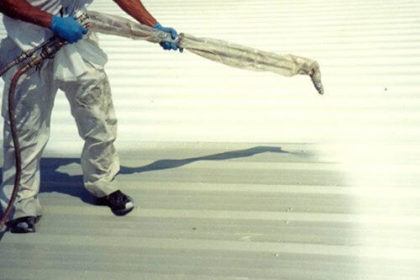 Uniflex Acrylic Elastomeric Coating Spec For Metal Roofs
Uniflex Acrylic Elastomeric Coating Spec For Metal Roofs
If you believe you'll be saving the roof decking plywood (not replacing it), then you might conserve yourself some clean-up problem by removing the fixtures initially and after that peeling up the rubber! Information of water damage on camper roofing system. More water harmed locations on RV roofing system decking. There was nothing truly awful that made me seem like I was going to fall through, but definitely a great deal of damage and I was getting the feeling I would be replacing a lot of the roofing system decking plywood.
 Elastomeric Roof Coating
Elastomeric Roof Coating
Why Not Try These Out: roof maintenance - DC Roofing of Arizona
I chose the most basic one initially, a vent cap from a cooking area sink plumbing vent pipe. Beginning to scrape caulk and sealant. I used a stiff scraper with a chisel-like blade and simply began prying and chipping and scraping and hacking. There is no other method around this, you just need to start digging up until you expose the screw heads.
Unscrewing the screws in vent cap. The screws on this vent cap were hex-head metal screws so I utilized a small socket motorist to remove them. Some came out clean. Others were rusted and I needed to utilize a vice-grip pliers to get the heads and turn them bit by bit.
I found an old wasp nest inside the vent cover. This is a sight I'll most likely need to get utilized to, discovering the remains of animal habitation in every nook and cranny. I invest a dreadful great deal of my time developing good wildlife environment in my lawn so I do not get angered when a creature picks to set up house in my RV.
How-to: Apply Cool Roof Coating
Luckily no one was home in this old nest so I just tossed it. Possibly I'll put a screen over it when replacing it. Which brings us to the next point. You must try not to damage these pieces (like vent covers and caps) as you're scraping off the old caulk and sealant simply in case you require to utilize them once again.
(Think I'll discover when the roofing is done!) Prying up the vent cap and removing the last ring of rubber roofing beneath. So I pried up the remainder of the cap and scraped up the staying rubber roofing and butyl tape and putty and 25 years of other gunk and here's how it looks cleaned up.
 Roof Coatings, Roof Paints And Waterproof Roof Coatings
Roof Coatings, Roof Paints And Waterproof Roof Coatings
One down, 7 more components to go. Next I chose to take on the only roofing ventilation fan that my camper has. My roof vent also had a vent cover over it. So I began scraping the gunk from those screws. Tucson roof repair - DCRoofingArizona.com Starting on the roof vent. Hardware exposed on roofing vent cap, the first nut came off clean.
 What Is A Roof Restoration?
What Is A Roof Restoration?
Bolt is spinning. The fasteners on this Recreational Vehicle roofing system vent cover were nuts on small bolts. The very first one came off fine with an extension socket set. The second one simply started spinning, suggesting the bolt was not repaired in location but turning together with the nut. Disappointment. A peek at the hardware holding down the roof vent cover.
Do Mobile Home Roof Coatings Really Work?
I didn't have any great way to hold the bolt in place so rather I chose to saw through the bolts with a reciprocating saw. Sawing through bolts on roof vent cover. I used a cordless reciprocating saw with a metal-cutting blade however it was challenging to get the blade flat enough to reach the bolts so near to the roof deck. Most were so old and rusted that they sheared off when I loosened then with a great deal of force. Unscrewing the brackets that held the vent cover in place. Then I scraped more caulk and roofing sealant off the flange of the roofing vent itself. I soon discovered there were no more screws or hardware holding it down so I quit on the scraping and went inside the Recreational Vehicle After scraping the caulk and sealant from flange of roofing system vent, say goodbye to screws! Loosening the within cover plate of roofing system vent fan in RV restroom.
A couple sheared off with a great deal of force, however two would not budge. So I needed to drill out the screw heads. I chose a drill bit near to the size of the shaft of the screws that I had actually already taken out and started drilling. Selecting a drill bit for drilling out a screw head.
Shatterproof glass suggested. So I drilled out the heads, one popped off and the other I was getting upset with and provided it a pull before it was drilled through. Instead of popping off the screw head, the plastic just dissolved around the hot screw head. Whoops. Hope I do not need to recycle this cover.
If not, I'll need wider screw heads when re-assembling. Cover plate removed from roofing system vent. Next I discovered little corner brackets with hex-head bolts holding them in. I unscrewed them (all came out great the good news is) and took out the brackets and little white plastic spacers. Loosening corner brackets in roofing system vent.
Proper Surface Preparation Is Essential Before Applying Roof
All corner brackets got rid of, ready to take out. Once the brackets were out I returned up leading to pry out the the roof vent. Then I scraped up all the staying gunk and rubber roof. Lifting off the old roof vent. There are two wires running to the roofing vent (a black hot wire and a white neutral wire) that you'll need to clip to eliminate the old vent.